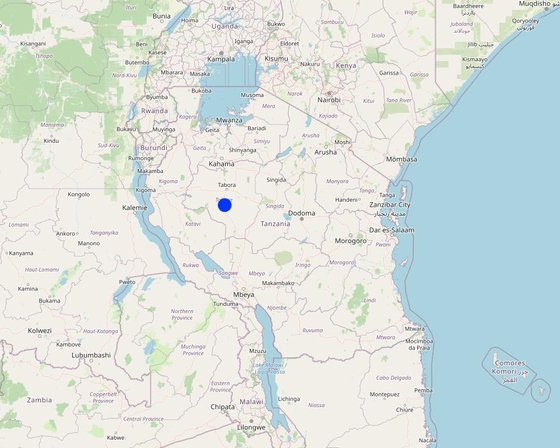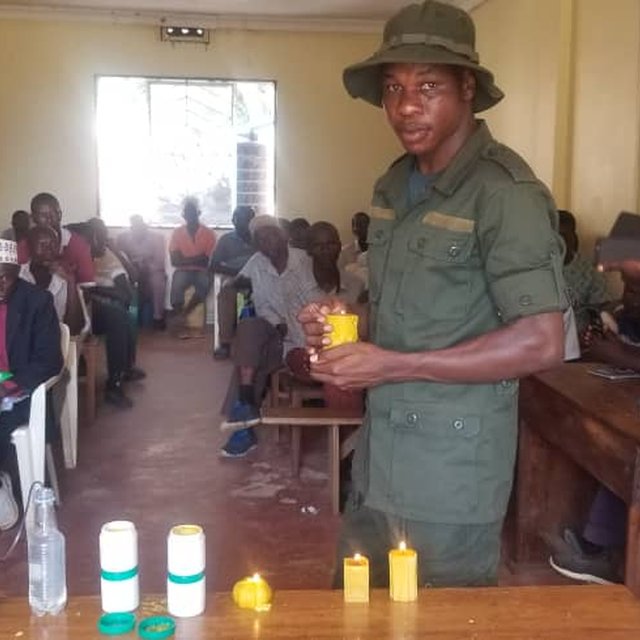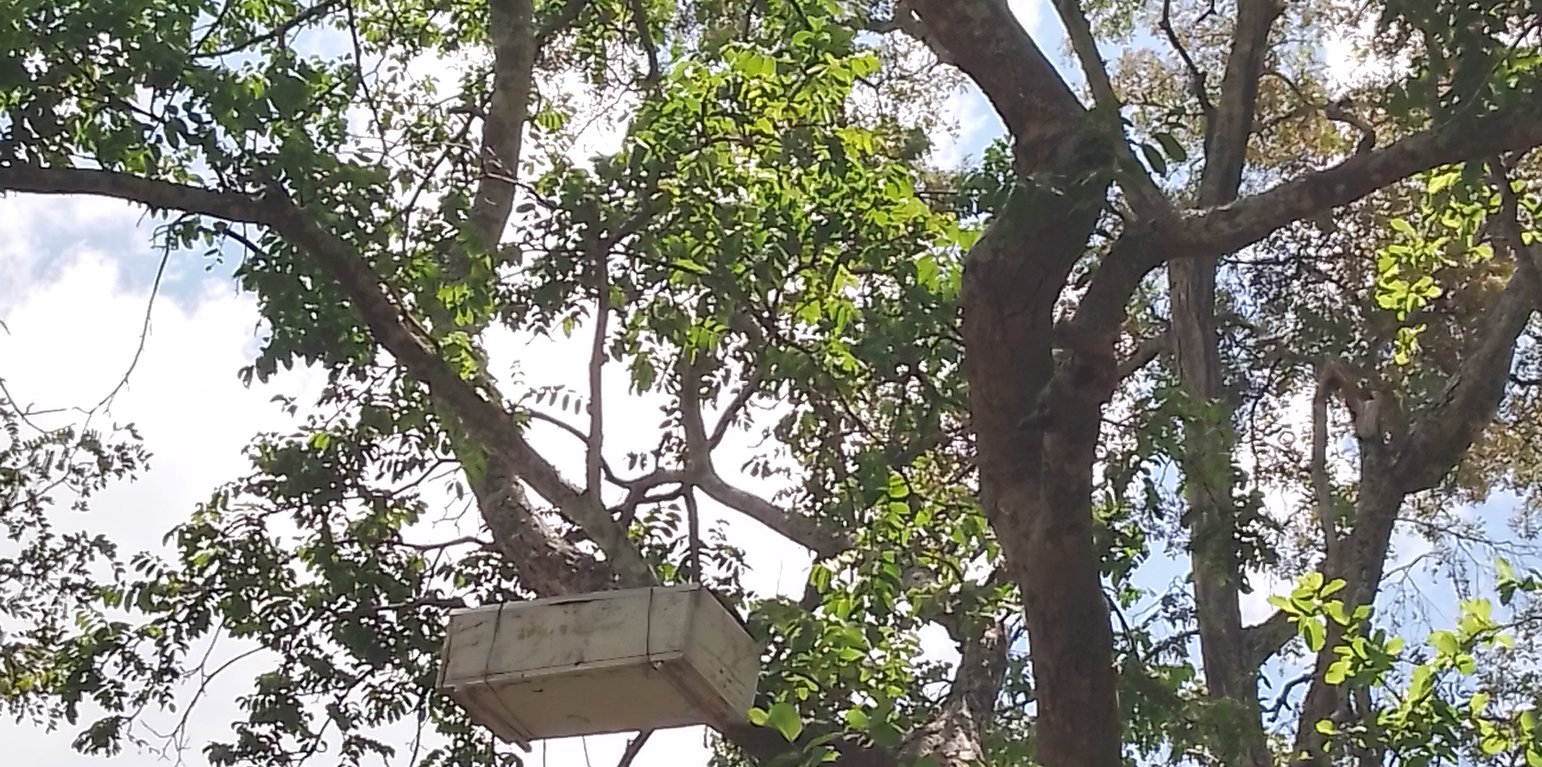BEEKEEPING FOR CONSERVATION OF NATURAL TREES AND FOREST RESERVES
(Tanzania, United Republic of)
UFUGAJI NYUKI
Description
Beekeeping is an activity which involves maintenance of bee colonies by using man-made hives within a selected forest area which provides the required feed and habitat resources required by bees. Through beekeeping, trees are conserved as they provide flowers hence ensuring feeds for bees. Beekeeping is used as an approach of protecting forest reserves against encroachments. Bee products, produced within the value chain, improve the livelihoods of beekeepers and communities at large while conserving the environment at the same time.
Beekeeping is an activity which involves care and management of honeybees for production of bee products, mostly honey and bee-wax. Beekeeping is an environmentally friendly activity ensuring conservation of trees and other forest resources protected through it. Therefore, beekeeping is undertaken for two major purposes which are:
•Production of bee products through which livelihoods of beekeepers and communities at large are improved and;
•Protection of trees and thereby, forest water resources.
Beekeeping is largely dictated by weather/climatic conditions; hence it is very crucial for the beekeeper to understand the rhythm of various seasons for successful beekeeping.
In this approach, trainings were provided to beekeepers in a community in Tabora Region, Sikonge District, on modern beekeeping techniques and skills which involve the use of modern hives and tools for increased production of bee products. Beekeepers were trained on:
•Measures which can be taken to ensure successful honey and wax production and;
•Measures required to adapt to impacts on bees from climate change.
Representatives from the Miombo Beekeeping Group (user group) are experienced beekeepers who have been in the field for a long period. Land users/beekeepers liked the approach because beekeeping does not require a lot of time due to its seasonal nature. Therefore, a beekeeper can have, besides beekeeping activities, ample time for carrying out other production activities, e.g. agricultural activities. Also, beekeeping does not require large areas of land and beekeeping can therefore, be integrated with other activities.
Insufficient capital for accessing modern hives and tools is one of the hinderances which make it hard for some of beekeepers to adopt improved beekeeping approaches.
Location

Location: SIKONGE DISTRICT, TABORA, Tanzania, United Republic of
Geo-reference of selected sites
Initiation date: n.a.
Year of termination: n.a.
Type of Approach
-
traditional/ indigenous
-
recent local initiative/ innovative
-
project/ programme based

Training to beekeepers on value addition of bee products by a beekeeping officer. (OCTAVIAN MLENGA)
Approach aims and enabling environment
Main aims / objectives of the approach
1. Beekeeping is practiced as a method of conservation of trees and other potential resources against encroachment from illegal timber harvesting, specifically in forest reserves.
2. Beekeeping is further developed for diversification of income sources so as to have access to other bee products besides honey which is commonly used as food and medicine.
3. On-farm beekeeping ensures pollination of crops thereby increasing crop yields.
Conditions enabling the implementation of the Technology/ ies applied under the Approach
-
Social/ cultural/ religious norms and values: Beekeeping being one of the traditional practices in this area, minimum energy and resources are required on promoting and sensitizing individuals to undertake beekeeping as they are experienced with it. Knowledge transfer is shared from one generation to another within families as members are engaged in management of beehives and other beekeeping activities throughout.
-
Institutional setting: For effective management of beekeeping activities, institutions have placed beekeeping officers for administration and supervision of beekeeping activities by linking beekeepers to the Government.
-
Collaboration/ coordination of actors: Beekeepers tend to form groups within their communities, through which they undertake their beekeeping activities. Through such beekeeping groups, they are easily reached by the government for trainings, technical support and financial grants that are given to groups who apply for projects specifically on beekeeping activities. Various stakeholders collaborate with the government by providing technical support to beekeepers in terms of skills and tools required.
-
Legal framework (land tenure, land and water use rights): In Tanzania, beekeeping is allowed to be undertaken in forest reserves and bee reserves. Beekeepers are granted with an entry permit into reserves for undertaking their beekeeping activities. Because of the presence of diverse plant species that flower at different seasons and also the security of their beehives, beekeepers prefer beekeeping in protected areas.
-
Policies: Beekeeping is one among the Departments within the Ministry of Natural Resources and Tourism which has policies and regulations in place.
-
Land governance (decision-making, implementation and enforcement): The presence of laws that govern management of forest and bee reserves as well as by-laws, against encroachment by illegal human activities, ensures the security of natural resources required by bees.
-
Knowledge about SLM, access to technical support: Hands-on trainings to beekeepers are provided through extension services by beekeeping officers. Also, the presence of institutions in the country which provide technical knowledge on modern beekeeping techniques ensures professionalism and sustainable beekeeping practices.
-
Workload, availability of manpower: Beekeeping activity requires manpower for hives making and for hanging hives on trees. Here, beekeepers tend to assist among themselves. Women who undertake on-tree beekeeping activities depend on men during the time of taking up/down of bee hives.
Conditions hindering the implementation of the Technology/ ies applied under the Approach
-
Availability/ access to financial resources and services: Beekeepers do not have reliable access to financial resources (capital) which could enable them to acquire modern beekeeping tools and production facilities. They cannot access loans from financial institutions for undertaking beekeeping activities as beekeeping relies on weather/climatic conditions for productions, whereas beekeepers cannot be assured of their productions in terms of quantities.
-
Markets (to purchase inputs, sell products) and prices: Beekeepers do not have a readily available market of their products. Because of this, they are forced to sell their products through middlemen (traders). This results in lower returns to producers. Also, because of financial constraints, farmers do not have access to modern beekeeping tools and facilities for increased production and product quality assurance.
-
Other: Climatic changes can have impacts on beekeeping activities, hence affecting production. For instance, during heavy rains flowers tend to fall down from trees thus affecting bee feed availability resulting in lowered honey production.
Also, when the rain is too small, the flower production on trees is minimum resulting in low feed availability for bees.
Participation and roles of stakeholders involved
Stakeholders involved in the Approach and their roles
| What stakeholders / implementing bodies were involved in the Approach? |
Specify stakeholders |
Describe roles of stakeholders |
| local land users/ local communities |
Beekeepers from a beekeeping group Known as MIYOMBO GROUP were involved in application of this approach. |
The role of the involved user group in this approach includes undertaking beekeeping activities for conservation of trees and natural resources. They are experienced with the practice and therefore they can undertake beekeeping. |
| national government (planners, decision-makers) |
The National Government under its agency known as Tanzania Forest Services Agency |
Providing technical support by providing skills and modern tools for beekeeping activities. |
Involvement of local land users/ local communities in the different phases of the Approach
none
passive
external support
interactive
self-mobilization
initiation/ motivation
Beekeepers at individual levels are mobilized to form formal beekeeping groups through which participatory analysis of the beekeeping activities is done by collaborating with the beekeeping officers and local administrative units. Thereafter, they develop plans which provide guidance and assistance to beekeepers especially to the new actors in the sector.
planning
Beekeeping activities are planned by the beekeeper who is provided with technical support from beekeeping officers specifically on techniques and skills that can be employed for increased production of bee products.
implementation
Beekeeping involves the use of modern skills and techniques which are provided to beekeepers through government institutions and agencies. For instance, Tanzania Forest Services Agency under the Ministry of Natural Resources and Tourism, are mandated by the Government on supervision of all forest and bee resources towards ensuring sustainable production. The agency collaborates with beekeeping groups during implementation of beekeeping activities.
monitoring/ evaluation
Government agencies facilitate monitoring/evaluation of beekeeping activities, production and marketing of products. The government possess a database of beekeepers in all the districts, which enables tracing of the specific source of bee products from producers and their locations.
Decision-making on the selection of SLM Technology
Decisions were taken by
-
land users alone (self-initiative)
-
mainly land users, supported by SLM specialists
-
all relevant actors, as part of a participatory approach
-
mainly SLM specialists, following consultation with land users
-
SLM specialists alone
-
politicians/ leaders
Decisions were made based on
-
evaluation of well-documented SLM knowledge (evidence-based decision-making)
-
research findings
-
personal experience and opinions (undocumented)
Technical support, capacity building, and knowledge management
The following activities or services have been part of the approach
-
Capacity building/ training
-
Advisory service
-
Institution strengthening (organizational development)
-
Monitoring and evaluation
-
Research
Capacity building/ training
Training was provided to the following stakeholders
-
land users
-
field staff/ advisers
Form of training
-
on-the-job
-
farmer-to-farmer
-
demonstration areas
-
public meetings
-
courses
Subjects covered
1. MODERN BEEKEEPING PRACTICES AND TOOLS FOR SUSTAINABLE PRODUCTION OF BEE PRODUCTS.
2. VALUE ADDITION OF THE PRODUCED BEE PRODUCTS FOR IMPROVED LIVELIHOOD AND INCOME GENERATION.
Advisory service
Advisory service was provided
-
on land users' fields
-
at permanent centres
Trainings are provided to beekeepers at their local communities, within their groups (producer organizations), which consist of members who have the common interest on beekeeping activities.
Institution strengthening
Institutions have been strengthened / established
-
no
-
yes, a little
-
yes, moderately
-
yes, greatly
Describe institution, roles and responsibilities, members, etc.
Tanzania Forest Services Agency, a government agency mandated by the government to supervise sustainable productions of forest and bee products. In this approach, the agency has been strengthened by collaborating with beekeepers who ensure sustainable protection of forest resources as well as production of bee products. Also, the local government around the area where beekeeping approach is undertaken has been strengthened through livelihood improvement of the community.
Type of support
-
financial
-
capacity building/ training
-
equipment
Further details
The Tanzania Forest Fund provides technical and financial support to beekeeping groups which have written up projects upon their call on project write ups, specifically on beekeeping and forest conservation. Modern beekeeping skills and techniques are offered to beekeepers by government agencies/institutions that are related to beekeeping and marketing.
Monitoring and evaluation
Beekeeping activities can be monitored and evaluated through the data base containing a register of beekeepers and their productions.
Financing and external material support
Annual budget in USD for the SLM component
-
< 2,000
-
2,000-10,000
-
10,000-100,000
-
100,000-1,000,000
-
> 1,000,000
Precise annual budget: n.a.
- Own source/savings of beekeepers
- Financial institutions
- Government grants
The following services or incentives have been provided to land users
-
Financial/ material support provided to land users
-
Subsidies for specific inputs
-
Credit
-
Other incentives or instruments
Financial/ material support provided to land users
Technical support from one financial institution within the community, (National Microfinance Bank); which supported 2 beekeeping groups with 50 modern beehives for each group and protective cloths for increased production of bee products.
partly financed
fully financed
equipment: machinery
The Government provides subsidies to beekeepers by providing them with modern machines which can be used to ease operations and processing of bee products. The only condition to receive the subsidy is that beekeepers should be within a formal group, and they receive the subsidy in terms of materials and not finance.There is no any returns required from beekeepers to the government on this subsidy provided by the Government.
equipment: machinery: tools
Modern tools are provided to beekeepers by the Government for easy undertaking of their beekeeping activities. These includes tools like smokers, beehives, protective clothing as well as packaging materials. There is no any returns that is required from the beekeepers to the Government after being given the tools.
Labour by land users was
-
voluntary
-
food-for-work
-
paid in cash
-
rewarded with other material support
Other incentives or instruments
Existence of a project that works on this community, dealing with the beekeeping value chain activities, from production to harvesting of bee products promotes and ensures sustainable productions of bee products with quality adherence.
Impact analysis and concluding statements
Impacts of the Approach
No
Yes, little
Yes, moderately
Yes, greatly
Did the Approach empower local land users, improve stakeholder participation?
The approach has united users (beekeepers) with Government agencies, institutions and NGO's who empower them through technical and financial support.
Did the Approach enable evidence-based decision-making?
Beekeeping ensures protection of natural forest/tree resources. This facilitates decision making of the Government towards promoting and enhancing beekeeping activities.
Did the Approach help land users to implement and maintain SLM Technologies?
Beekeeping, one of the environmental conservation practices ensures SLM & SFM practices, because trees i.e flora species are conserved as they provide bee feed and bee habitats.
Did the Approach improve coordination and cost-effective implementation of SLM?
Beekeeping, is an environmentally friend activity with low running cost.
Did the Approach mobilize/ improve access to financial resources for SLM implementation?
Through beekeeping groups, support can easily be attained from the Government (Tanzania Forest Fund) and institutions such as banks and other NGO's.
Did the Approach improve knowledge and capacities of land users to implement SLM?
Improved knowledge of beekeepers leads to more products and enables SFM (sustainable forest management) practices.
Did the Approach build/ strengthen institutions, collaboration between stakeholders?
Through beekeeping, agencies and institutions that are involved in production and marketing of bee products collaborate. For instance, honey produced is used as food, this will bring on board the agency dealing with food health security.
Did the Approach empower socially and economically disadvantaged groups?
Tanzania Forest Fund provide grants to beekeeping groups, when members unite and create a group, write up their project they can be facilitated as well with regard to beekeeping and conservation activities.
Did the Approach improve gender equality and empower women and girls?
Women also participate in beekeeping activities and honey production but not to a large scale as compared to men. This is because, this activity is preferred to be undertaken in forest reserves which are far from homes/villages and therefore making it unease for women participation.
Did the Approach encourage young people/ the next generation of land users to engage in SLM?
Youth are fully engaged in beekeeping activities by assisting throughout the whole process thus learning beekeeping as well.
Did the Approach lead to improved food security/ improved nutrition?
Bee products that are produced are sold and therefore providing income to the family which ensures food accessibility.
Did the Approach lead to improved access to water and sanitation?
Did the Approach lead to employment, income opportunities?
Beekeeping provides employment opportunities to the beekeeper and other individuals.
Main motivation of land users to implement SLM
-
increased production
-
increased profit(ability), improved cost-benefit-ratio
-
reduced land degradation
-
reduced risk of disasters
-
reduced workload
-
payments/ subsidies
-
rules and regulations (fines)/ enforcement
-
prestige, social pressure/ social cohesion
-
affiliation to movement/ project/ group/ networks
-
environmental consciousness
-
customs and beliefs, morals
-
enhanced SLM knowledge and skills
-
aesthetic improvement
-
conflict mitigation
Sustainability of Approach activities
Can the land users sustain what hat been implemented through the Approach (without external support)?
Beekeepers use locally available materials for undertaking their beekeeping activities from hives construction to honey processing.
Conclusions and lessons learnt
Strengths: land user's view
-
Provides sources of income to the family through the produced bee products.
-
Access to bee products which are used as food, medicines and sale as industrial ingredients of various products.
-
Pollination of crops when practicing on-farm beekeeping.
Strengths: compiler’s or other key resource person’s view
-
Effective means of conservation of trees and natural resources.
-
Ensures livelihoods improvements through diversified sources of household income.
-
A way of maintaining the traditional/cultural practices that have been practiced from previous generations.
Weaknesses/ disadvantages/ risks: land user's viewhow to overcome
-
Climatic changes which affects beekeeping production.
Beekeepers should be capacitated with skills on how to adapt to climate changes for assured production.
-
Encroachments by illegal human activities in potential areas for beekeeping affecting productions.
Protections of forest and bee reserves should be strengthened so as to ensure bee feed availability.
Weaknesses/ disadvantages/ risks: compiler’s or other key resource person’s viewhow to overcome
-
Women participation in beekeeping productions within the value chain is still very low as compared to men.
Promote on-farm beekeeping to women so that they can also participate in the production of bee products. Women should be influenced to participate on beekeeping activities.
-
Lack of enough capital by beekeepers for upscaling beekeeping practices in a modern way.
Linking beekeepers to markets that will assure them good income and profit generation so to expand their activities and apply modern tools such as hives for increased productions.
References
Date of documentation: Nov. 19, 2024
Last update: Jan. 22, 2025
Resource persons
-
LINDA SHIO (shiolinda11@gmail.com) - co-compiler
Full description in the WOCAT database
Documentation was faciliated by
Institution
- TANZANIA FOREST SERVICES AGENCY (TFS)
Project
- Global coordination project for the SFM Dryland Sustainable Landscapes Impact Program (GEF-FAO / DSL-IP)
Links to relevant information which is available online





